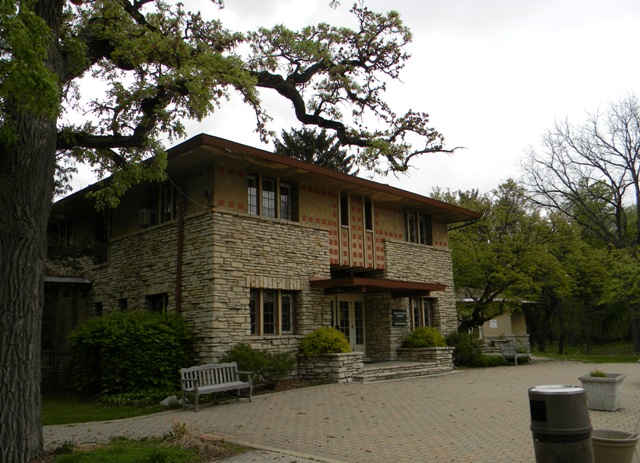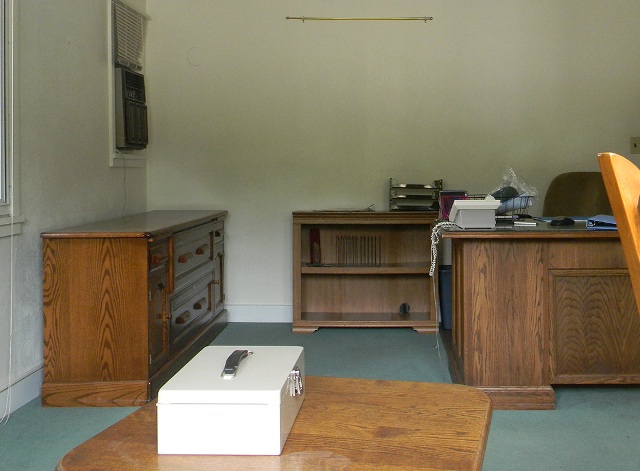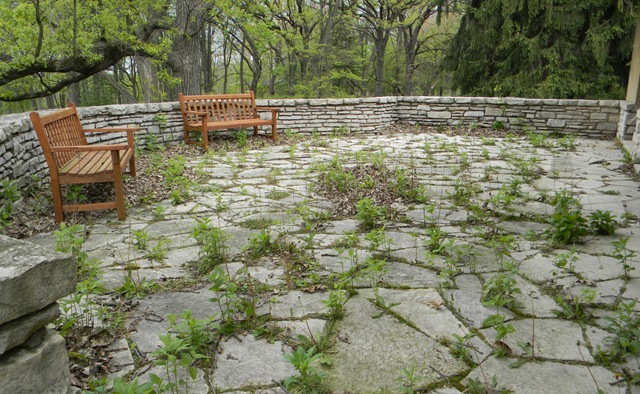Elgin's Imperiled Gem
May 2, 2012
The former administration building at the Fox River Country Day School is included in a campaign to save the campus by a state preservation organization. Photo by News Bulletin staff.
It’s been nearly a year since final classes were held at Elgin’s Fox River County Day School and the now-empty 53-acre campus has a forlorn feel.
Dust gathers in empty administrative offices, weeds are starting to take over a flagstone patio and once-busy playgrounds stand silent.
The 150-student school shut its doors after 98 years at the end of the 2010-11 school year, a victim of declining enrollment and decreasing funds.
The campus, located on Illinois Route 31 near Interstate 90, is currently in foreclosure.
But a statewide group of preservationists hopes to save the property–home to several significant buildings designed by Prairie Style architect John S. Van Bergen.
Chicago-based Landmarks Illinois highlighted Fox River County Day School as one of Illinois’s 10 most endangered historic places at at April 24 news conference in Springfield.
“This is a rare and beautiful campus of Prairie School-style buildings by the noted architect John Van Bergen,” said Jean Follett, Interim Executive Director of Landmarks Illinois. “We hope local officials will work with potential buyers to create an appropriate redevelopment plan for this unique campus and its beautiful natural setting.”
Landmarks Illinois named eight other endangered historic properties as well as a thematic grouping to its annual list which focuses attention on sites that are threatened by deterioration, lack of maintenance, insufficient funds, or inappropriate development.
The Fox River Country Day School was built in 1923 as the Chicago Junior School. The campus includes buildings designed by Van Bergen as well as 53 acres of natural oak savannah.
The low-profile buildings have wonderful tile details, stucco and stone walls and great sensitivity to the rolling site. Due to the school’s current lack of protection the buildings could be demolished as part of a redevelopment.
Around 150 students attended Fox Valley Country Day, split between commuters and students living in on-campus dormitories.
According to the school’s still-active web site it was founded by Morris Schwabacher and V.P. Randall on the shores of Long Lake, Michigan, on Memorial Day, 1913. These two men shared a desire to help some of the many half-orphaned boys roaming around the stockyards of Chicago.
Originally named Chicago Junior School, it began as an active farm, with no more than a tent and superabundant wilderness. This helped instill many life and work values in the students, characterizing the unique program of CJS.
On Memorial Day, 1923, the school moved to its present location in Elgin. The new property was also a working farm, as still evidenced by the silo in the middle of campus.
In 2003, the Board adopted a new name for the school to better reflect what the school is and where it is located: Fox River Country Day School.
The school emphasized its Christian heritage through exemplary personal and academic standards, an expectation of high moral and ethical practice, and a commitment to community values and service.
Listing in the National Register of Historic Places or local landmark designation would allow a future developer to utilize historic tax credits for the rehabilitation and reuse of the buildings. The City of Elgin cannot protect the buildings through local landmark designation without owner consent.

A bankruptcy sale sign (above) dominates the entry to the now-shuttered Fox River Country Day School while a peek into the administration building shows empty offices (below). At bottom, weeds start to pop up between the cracks on a now unused patio. Fox River Country Day closed down at the end of the 2010-11 school years. The property was highlighted as endangered by a state preservation group this month. Photos by News Bulletin staff.


Since the inception of Landmarks Illinois’ Ten Most list in 1995, more than a third of the listed properties have been saved, less than a quarter have been demolished, and the rest remain threatened or are being rehabilitated.
This year’s list also includes: an 1854 limestone house, a twelve-story terra-cotta clad office tower, a turn-of-the-century city hall, a Georgian Revival building that housed the widows of Civil War soldiers, a 1928 former residential hotel, a 19th-century farmstead, a Bertrand Goldberg-designed modern hospital, an exceptional residential design by the mid-20th-century architecture firm of Keck & Keck and a grouping of five “historic neighborhood schools.”
Landmarks Illinois has been working to protect historic places throughout Illinois for over 40 years. The not-for-profit works with citizens and communities to preserve historic places and promote awareness about them through education and advocacy.
In addition to the Ten Most Endangered list, the organization also sponsors an annual awards program and a matching grant program for County Courthouses.
The complete Ten Most list, including photos of the sites, is available at www.Landmarks.org through the “Press Room” link.







